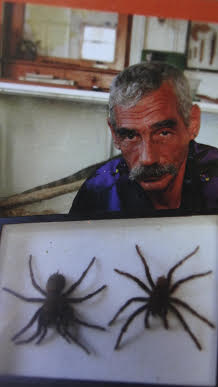Pinkfoot goliath facts for kids
Quick facts for kids Pinkfoot goliath |
|
|---|---|
| Scientific classification | |
| Synonyms | |
|
Pseudotheraphosa apophysis Tinter, 1991 |
The Pinkfoot Goliath Tarantula (scientific name: Theraphosa apophysis) is a very large type of spider. It belongs to the Theraphosidae family, which includes all tarantulas. You can find this amazing spider in countries like Venezuela and Brazil in South America.
Contents
What Does the Pinkfoot Goliath Look Like?
The Pinkfoot Goliath Tarantula looks a lot like its cousin, the Goliath Birdeater Tarantula. It can grow to be a similar huge size! When these spiders are young, they have pretty pink tips on each of their legs. But as they grow bigger and shed their skin (this is called moulting), these pink colors slowly fade away.
Special Features of This Spider
Theraphosa apophysis has some unique features. It has an extra special organ on its second leg. This organ helps the spider make sounds, like a scratching noise. This is called a stridulating organ. It's found on the coxa, which is the part of the leg closest to the spider's body.
Its upper leg parts, called femora, are thinner compared to the Goliath Birdeater. Male Pinkfoot Goliath Tarantulas have special bumps or projections on their lower leg parts, called tibial apophyses. This is actually where the spider gets its scientific name, apophysis!
Colors and Hair
Both male and female Pinkfoot Goliath Tarantulas are a coffee-brown color. Their legs and the back part of their body (called the opisthosoma) have long, scattered orange-brown hairs. The upper parts of their legs (the femora) also have long orange hairs.
When male spiders grow up, they get a shiny, metallic look. People describe this color as "wine red." You can see this shine on their main body section (the cephalothorax), the top of their jaws (the chelicerae), their small feeler-like legs (the pedipalps), and parts of their walking legs. This includes the coxa, trochanter (the next part of the leg), femur, and the patella (knee-like joint) of their first leg.
How Big Do They Get?
The female spider that scientists first studied was about 8.7 centimeters (about 3.4 inches) long from head to tail. Her longest leg, the fourth one, was about 9.6 centimeters (about 3.8 inches) long!
Male spiders are usually a bit smaller in body length. The male studied was about 8.0 centimeters (about 3.1 inches) long. However, his legs were slightly longer, with the fourth leg being almost 10.0 centimeters (about 3.9 inches) long.
How Scientists Named This Spider
Scientists have a special way of naming and grouping all living things. This is called taxonomy.
Discovery and First Name
The Pinkfoot Goliath Tarantula was first described by a scientist named Andreas Tinter in 1991. He first called it Pseudotheraphosa apophysis. Mr. Tinter actually bought one of these spiders, thinking it was a different kind. But he soon realized it was special because it had those sound-making organs. After more study, he decided it was a brand new species and gave it a new genus name, Pseudotheraphosa.
Changing the Name
Later, in 2001, another scientist named Rogério Bertani did a deep study of how different spiders are related. This is called a phylogenetic analysis. Based on his findings, he suggested that this spider actually belonged in the Theraphosa group, not Pseudotheraphosa. Other scientists have agreed with this idea since then. So, its official name became Theraphosa apophysis.
Keeping Pinkfoot Goliath Tarantulas as Pets
Some people like to keep tarantulas as pets. However, the Pinkfoot Goliath Tarantula is considered a challenging pet to take care of. It's generally not recommended for people who are new to keeping tarantulas.
Why They Are Hard to Care For
These spiders can be quite nervous and defensive. This means they might get scared easily or try to protect themselves if they feel threatened. They also need a very specific environment, especially high humidity (lots of moisture in the air). Keeping the humidity just right can be tricky for beginners.
Why Experienced Keepers Like Them
Even though they are challenging, more experienced tarantula keepers often like them. This is because of their impressive large size. They are also known to be "food-aggressive," meaning they eat very well and grow quickly. These traits make them exciting for people who know how to provide the right care.
See also
 In Spanish: Theraphosa apophysis para niños
In Spanish: Theraphosa apophysis para niños


